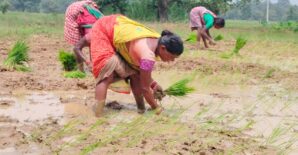BY SUDHA NARAYANAN, SHREE SAHA
Indian government’s stringent lockdown approach to prevent the spread of the COVID-19 pandemic resulted in a surge in food prices for the consumers, while farmers experienced a sharp fall in prices. Sudha Narayanan and Shree Saha describe the rise in prices for specific food commodities and the operational challenges faced by the retailers, despite the efforts by national and state government to restore the supply chain. They provide recommendations to ease the supply chain hurdles that go beyond price control and stocking limits to ensure adequate supply such that the complementary efforts to support demand can become useful. - Rasmi Avula, series co-editor and Research Fellow, Poverty, Health, and Nutrition Division (PHND)

Rajasthan, India : Vendor selling vegetables near a closed market after it was shut down as a precautionary measure against coronavirus in Beawar. Shutterstock/Sumit Saraswat
The nation-wide lockdown, undertaken by Government of India as a key intervention to contain the spread of COVID-19, has been regarded as among the most stringent in the world. Announced on March 24, 2020, the lockdown came into force within four hours, leaving little time for people to prepare. Initially planned for 21 days, the lockdown was later extended to May 3, 2020 (then again to May 18, 2020). In principle, the lockdown allowed free movement of ‘essential’ commodities and operations relating to food processing. It was also supposed to allow food markets to function without impediments. In reality, those involved in food supply chains faced insurmountable challenges, including intermittent closure of wholesale markets for agricultural produce1 and restrictions on movement of vehicles, both across state borders and within cities.
Even as demand in cities appeared to have declined with restaurants and eateries staying shut, supply constraints were so severe that many worried that this would lead to an increase in food prices. Using publicly available data from the Ministry of Consumer Affairs, Food and Public Distribution, Government of India, covering 22 food commodities from 114 urban centres that track wholesale and retail price movements for each commodity during the lockdown period, we find these fears to be true. We compute an aggregate retail food price index and wholesale food price index (RFPI and WFPI, respectively) that represent the weighted average for the 22 commodities, which is then aggregated across centres using 2011 Census population as weights.
Rising food prices & other challenges
While food prices in India were declining consistently since early 2020, supply disruptions consequent to the lockdown appear to have reversed the trend as of April 21, 2020 (Figure 1). Though the RFPI and WFPI show modest increases (3% relative to the eve of the lockdown)2 this is especially concerning because of a widespread loss of employment and wages. Further, this masks large variations across commodities and geographies. Average retail price increases are over 6% for several pulses, over 3.5% for most edible oils, 15% for potato, 28% for tomato in the 28 days post-lockdown compared to prices during the month preceding the lockdown. Chicken and mutton prices have increased dramatically over the past two weeks, even doubled in some cities. However, milk prices have been steady over this period.
The wedge between wholesale and retail prices show a marked increase post-lockdown, consistent with both the frictions in the supply chain as well as retailer power to price food. We find that on an average, smaller cities seem to have registered sharper increase in prices, when compared to larger cities and in some cases, going up by 20% relative to the eve of the lockdown. This is not unexpected since wholesale markets, where farmers typically sell, have been closed in most smaller towns, whereas those in the larger cities have operated at least a few days each week. Meanwhile, farmers are seeing a sharp decline in prices (halved in some cases) due to these closures and also on account of logistical risks deterring traders from procuring. A survey conducted with 50 food retailers in 14 cities highlights serious operational challenges associated with sourcing supplies, transportation, slump in demand and police harassment while moving goods and conducting business. While some retailers said that they are passing on the higher costs to consumers, others reported that they are absorbing these costs.
Figure 1: Retail and Wholesale Prices
Policy interventions to ease supply chain disruptions
Both the central and several state governments have made efforts to restore food supply chains. On March 26, the Government issued Standard Operating Procedures allowing those engaged in the supply chain of essential goods to commute on the basis of an e-pass. Several other notifications seek to ease supply chain bottlenecks. These include advice to facilitate workers in the food supply chain and transporters to function, permit e-commerce of essential goods, allow Micro, Small and Medium Enterprises (MSMEs), processing wheat flour, pulses and edible oils (April 12, 2020; April 21, 2020 allows this in urban areas) or more recently, the decision to allow certain shops to be open during the lockdown, subject to certain restrictions on locations and good sold (April 24, 2020).
Yet, in reality, vendors of fresh produce as well as transporters have faced considerable difficulties in securing movement passes and permissions for their operations. Several are unaware of the rules. Overzealous law enforcers have focussed on enforcing the lockdown, rather than maintaining food supply chains. There have also been worrying reports of social and religious discrimination in many cities – barring vendors belonging to certain minority communities from selling in some neighbourhoods, or barring entry of people from some ethnic background in certain supermarkets.
Way forward: Need to go beyond price controls
Our analysis thus far suggests that not only have the government circulars and entreaties been ineffective, there is also a need to desist from actions like price controls and stocking limits, where the power to enforce rests disproportionately with the local police and often manifests in ways that are counterproductive. For example, on April 7, the Ministry of Home Affairs had urged states to invoke and enforce the Essential Commodities Act to control hoarding, black marketing and profiteering by traders, and keep prices in check. Rather than attempting to control prices directly by invoking the Essential Commodities Act, the focus must sharply be on ensuring that private food supply chains are functional once again. Among other things, key priorities of governments at the centre and state should include the following:
- Governments must ensure that food retailers do not have to jump through hoops (via permissions and passes from various local authorities, beyond what is already required of them) to conduct business and create conditions for a safe and harassment-free environment to work.
- Many food processing units like pulses, sugar, grain and flour mills, solvent extractors and oil crushers, dairies and abattoirs might struggle to resume operations due to financial distress, continued shortage of labour and difficulties in sourcing supplies. Financial support to these units should be prioritized, especially in smaller cities.
- Many state governments are leveraging Farmer Producer Organizations (FPOs) to source supply with government-managed distribution of groceries in large cities as well as smaller towns and rural areas. Until the time, private supply chains are restored, these initiatives would serve as a lifeline. Continued provision of cooked meals would be important as well.
- Better price surveillance, especially in small town and rural areas, is required urgently as early warning signs have already started appearing in the form of supply shortages.
Unless the problem with distribution is addressed, other efforts might only yield limited impact. For example, while cash transfers need to be disbursed to support demand, unless supply constraints are also simultaneously released, these transfers will serve limited purpose. Also, there is a real risk that local inflation could reduce the value of cash transfers, leaving many vulnerable to hunger, malnutrition and starvation.
Sudha Narayanan and Shree Saha are with the Indira Gandhi Institute of Development Research (IGIDR), Mumbai. This article is based on a working paper available here. The analysis and opinions expressed in this piece are solely those of the authors.
This blog has been published as a part of the International Food Policy Research Institute (IFPRI), South Asia, blog series on analyzing the impacts of the COVID-19’s pandemic on the sub-national, national, and regional food and nutrition security, poverty, and development. To read the complete blog series click here
1 See Rawal, Vikas and Kumar, Ankit (2020), Agricultural Supply Chains during the COVID-19 Lockdown: A Study of Market Arrivals of Seven Key Food Commodities in India, SSER Monograph 20/1, Society for Social and Economic Research, for a detailed account on disruptions in producer markets. They point out, for example, that of the 325 markets where both grain and perishables are traded, only perishables were marketed in 100 mandis during the period of the lockdown, with the rest being dysfunctional. Of 449 markets, in which only grain was marketed during this period in 2019, 326 did not function at all during the lockdown.
2 This is likely an underestimate given that the prices were trending downwards at the time of the announcement of the lockdown
New research from a Special Issue of Applied Economic Perspectives and Policy
The pandemic caused disruptions to both the supply of and demand for health services that persisted past the lifting of lockdown measures.
Public food transfer programs have traditionally been the most common social protection programs in Bangladesh




